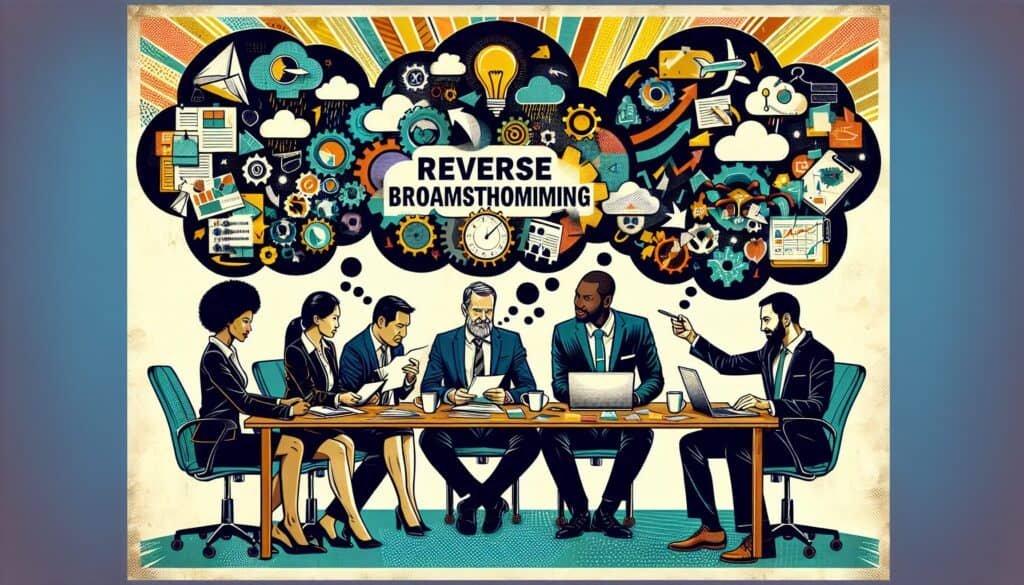Identificar posibles problemas, puntos débiles o formas en que un plan podría fallar, con el fin de abordarlos de forma proactiva.
- Metodologías: Clientes y marketing, Diseño de producto
Lluvia de ideas inversa

Lluvia de ideas inversa
- Lluvia de ideas, Gestión del cambio, Mejora continua, Análisis de fallos, Innovación, Técnicas de resolución de problemas, Mejora de procesos, Análisis de riesgos, Gestión de riesgos
Objetivo:
Cómo se utiliza:
- En lugar de preguntarse "¿Cómo podemos conseguir X?", el grupo se pregunta "¿Cómo podría fallar X?" o "¿Cómo podríamos hacer que X fallara?". A partir de los problemas identificados se generan soluciones.
Ventajas
- Ayuda a anticipar y mitigar riesgos; fomenta el pensamiento crítico; puede ser un buen punto de partida para los esfuerzos de mejora al centrarse en lo que hay que evitar.
Contras
- A veces puede conducir a un ambiente negativo o pesimista si no se gestiona bien; puede no ser adecuado para todo tipo de problemas; requiere replantear los problemas para convertirlos en soluciones.
Categorías:
- Ideación, Resolución de problemas, Gestión de riesgos
Ideal para:
- Identificar posibles problemas o formas en que un proyecto/idea podría fracasar, para luego encontrar soluciones.
Reverse brainstorming is particularly effective in industries such as product design, software development, and engineering, allowing teams to proactively identify failure modes before they manifest in real-world applications. This methodology is well-suited for the early phases of project development, such as concept design and feasibility studies, where understanding potential pitfalls can inform design choices and resource allocation. Facilitators can initiate sessions with diverse teams, including engineers, designers, marketing personnel, and stakeholders, ensuring a broad range of viewpoints and expertise is represented. Participants can collaboratively brainstorm various scenarios that might lead to a product’s failure, such as design flaws, market misalignment, or inadequate user testing. The findings from these discussions can then be systematically addressed through innovative problem-solving techniques, strengthening the robustness of the product or service. Industries that have successfully implemented reverse brainstorming include automotive design, where safety and performance are paramount, and consumer electronics, where understanding user experience and preventing product recalls are crucial. This proactive approach not only enhances the likelihood of success but also nurtures a culture of continuous improvement, fostering an environment where team members feel comfortable expressing concerns and suggestions. Tools like fishbone diagrams or affinity diagrams can be utilized during these sessions to visualize problems and categorize potential failures, thereby guiding the development of targeted solutions to mitigate risks that might otherwise derail a project.
Pasos clave de esta metodología
- Define the objective or project.
- Formulate failure-oriented questions related to the objective.
- Brainstorm potential ways the project could fail or obstacles that could arise.
- Encourage participants to think broadly and creatively about failure scenarios.
- Prioritize and categorize the identified potential failures based on impact and likelihood.
- Analyze the prioritized failures to identify root causes.
- Develop strategies or solutions to mitigate each identified failure.
- Assign responsibilities for implementing the solutions.
- Establish metrics for monitoring the effectiveness of the solutions.
Consejos profesionales
- Encourage team members to assume the mindset of a competitor or antagonist, enhancing the identification of potential failures from an opposing viewpoint.
- Utilize structured metrics to evaluate the identified risks and their likelihood of occurrence, ensuring prioritization of the most pressing concerns.
- Schedule follow-up sessions specifically for generating countermeasures based on the identified risks, promoting a culture of continuous improvement.
Leer y comparar varias metodologías, recomendamos el
> Amplio repositorio de metodologías <
junto con otras más de 400 metodologías.
Sus comentarios sobre esta metodología o información adicional son bienvenidos en la dirección sección de comentarios ↓ , así como cualquier idea o enlace relacionado con la ingeniería.
Contexto histórico
1949
1950
1950
1960
1960
1960
1960
1940
1950
1950
1958
1960
1960
1960
1960
(si se desconoce la fecha o no es relevante, por ejemplo "mecánica de fluidos", se ofrece una estimación redondeada de su notable aparición)















Publicaciones relacionadas
Cuestionarios sobre molestias musculoesqueléticas
Pruebas multivariantes (MVT)
Análisis de regresión múltiple
Sistemas de captura de movimiento
Método MoSCoW
Prueba de la mediana de Mood